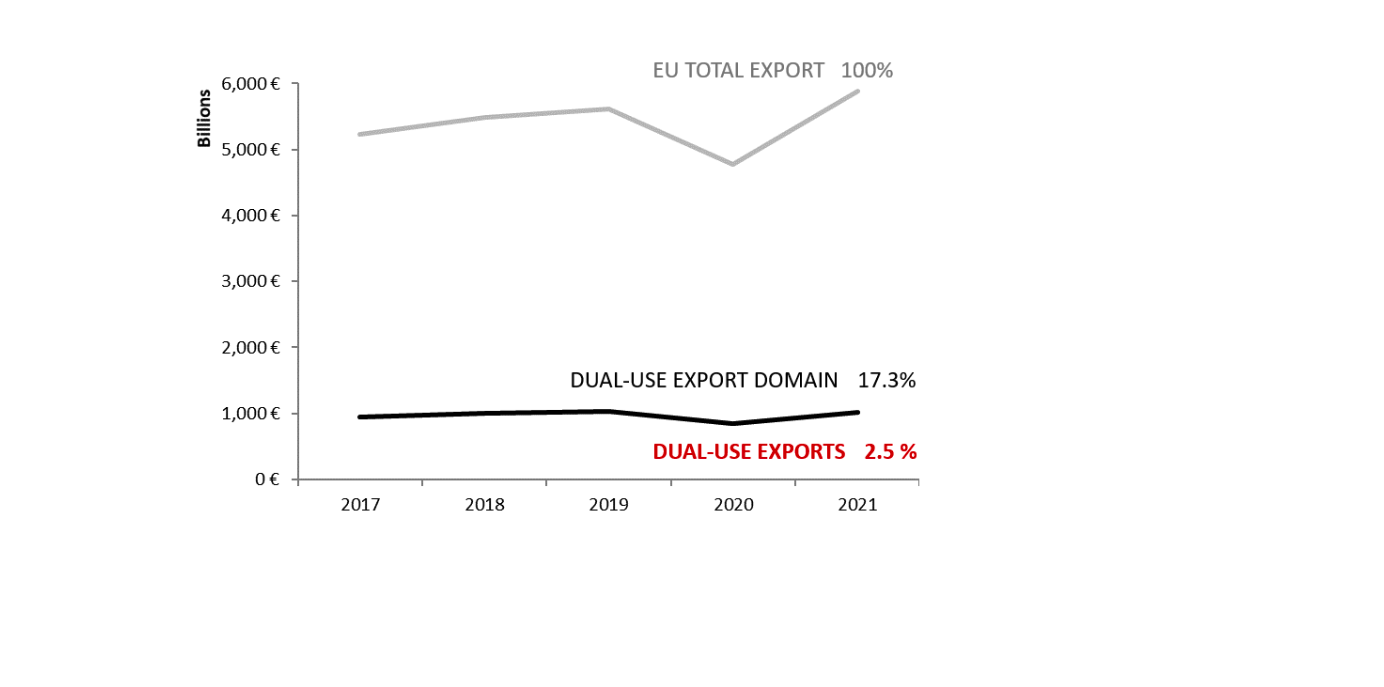2021 EU dual-use export control statistical update
On 19th October 2023, the European Commission published the statistical update[1] on the implementation of the EU Export Control Regulation of dual use items (Regulation (EU) 2021/821)[2]. This update is released, as in the previous year, jointly with the annual Foreign Direct Investment (FDI)[3] screening report, as both export controls and FDI screening establish strategic trade and investment controls to ensure security in the EU.
The report provides aggregated export control data for 2021, including an overview of dual use exports, with detailed statistics on the items and destinations involved. It contains key data on dual-use licensing, such as applications, authorisations and denials. It also shows key data on cyber-surveillance dual-use items.
Concerning the EU dual-use trade, data collected from Member States reveals that exports of dual-use items accounted for around 2.5% of total EU27 exports (intra- and extra-EU), with a dual use trade value of 147 billion euros. Based on statistics provided, the countries listed on the Union General Export Authorization[4]are the major destinations for dual-use exports[5]. The top five export destinations remain the same as in 2020, with the US leading the way, and the exception of the UK, which is introduced as a new export destination.
In regard to dual-use licensing, the applications totaled to a value of EUR 45.5 billion, corresponding to 2.1% of total extra-EU27 exports, while the authorised dual-use trade amounted to EUR 38.5 billion, representing 1.8% of total extra-EU27 exports. Individual[6] and global[7] licenses are the most frequently granted transactions, with only 568 denials reported. The top five countries for export licenses are China, South Korea, Taiwan, the United States, and the United Kingdom. France, Finland, the Czech Republic, Germany, and Belgium are the primary destinations for intra-EU transfers. Lastly, Category 5[8] of Annex I on Telecommunications and Information Security represents the top licensing category in terms of value.
A separate section concentrates on cyber-surveillance dual-use items and offers information gathered by the Surveillance Technology Expert Group[9]. Based on the graphs, the number of export licenses for these items increased from 37 in 2020 to 115 in 2021, with 3 and 35 denials in 2020 and 2021 respectively.
In conclusion, this document fills the data gap between the 2022 annual report – which covered 2020 data – and the 2023 report, which will be based on a new methodology[10] that will ensure a common approach which will solve the issue of Unharmonious data collection methodology[11] among Member States and it will soon be made available by the Commission and the Council and will apply to the reporting of 2022 data.
[1] The statistical update on the implementation of the Export Controls Regulation published by the European Commission complements the 2022 Annual Export Control Report Available at https://circabc.europa.eu/ui/group/654251c7-f897-4098-afc3-6eb39477797e/library/d45b2bfc-7029-412a-aa1e-b59ac87433f8/details?download=true
[2] Regulation (EU) 2021/821 of the European Parliament and of the Council of 20 May 2021 setting up a Union regime for the control of exports, brokering, technical assistance, transit and transfer of dual-use items (recast) (OJ L 206, 11.6.2021). Available at: https://eur-lex.europa.eu/eli/reg/2021/821/oj .
[3] Report from the Commission to the European Parliament and the Council Third Annual Report on the screening of foreign direct investments into the Union, 19/10/2023, available at https://ec.europa.eu/transparency/documents-register/detail?ref=COM(2023)590&lang=en
[4] EU General Export Authorisations allow exports of dual-use items to certain destinations under certain conditions (see Article 12(1) and Annex II of the Regulation (EU) 2021/821).
[5] The countries concerned by the Union General Export Authorization and listed in part 2 of the Annex I of the Regulation (EU) 2021/821 are: Australia, Canada, Iceland, Japan, New Zealand, Norway, Switzerland, including Liechtenstein and United States.
[6] Individual licences are licenses granted to one specific exporter for one end-user or consignee in a third country and covering one or more dual-use items.
[7] Global licences are authorisations granted to one specific exporter in respect of a type or category of dual-use items which may be valid for exports to one or more specified end-users and/or in one or more specified third countries.
[8] Article 3 of the Regulation 2021/821 stated that an authorisation shall be required for the export of dual-use items listed in Annex I. The dual use items referred to in the article are classified in 10 categories listed in Annex I of the Regulation.
[9] It is established within the Dual Use Coordination Group and composed of experts from Member States authorities to discuss with MS experts any issue related to the implementation of Regulation 428/2009 including with exporters.
[10] As the Regulation 2021/821 requires the Commission to publish an annual report that includes information on authorisations, denials and prohibitions, as well as information on the administration, and enforcement of controls. Then, a new reporting methodology is necessary in order to be in line with the requirement for enhanced transparency under the new Regulation (EU) 2021/821. This new methodology will be made available by the Commission and the Council and will apply to the reporting of 2022 data.
[11] It is difficult to obtain reliable economic information on overall dual-use exports (including non-listed dual-use items). There is indeed no official category of “dual-use items” in official economic, customs or trade statistics, in fact, the Commission and Member States collect data that allows for approximate estimates of exports of dual-use goods based, on the one hand, on specific licensing data shared on a voluntary basis by competent authorities and, on the other hand, on statistics for export declarations to EU customs which include dual-use goods.



No responses yet